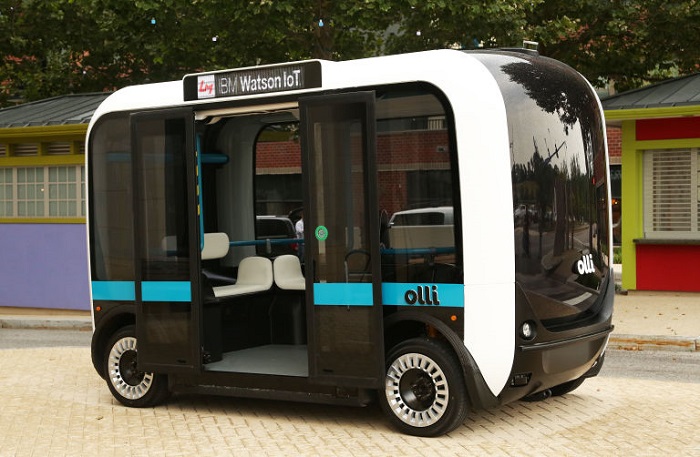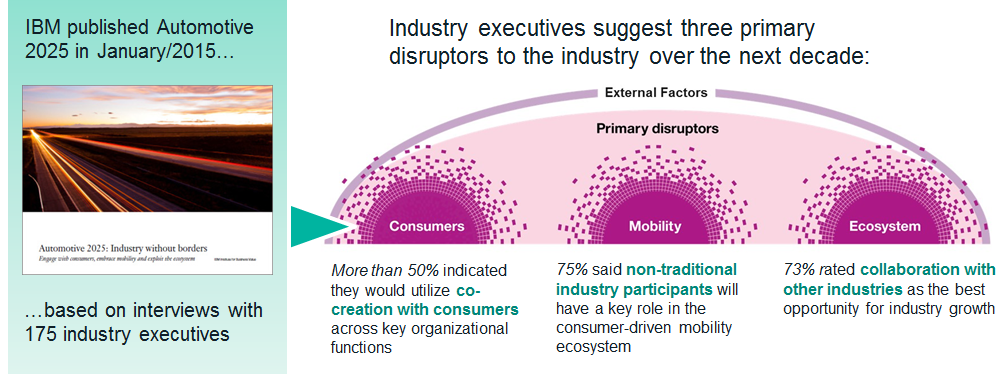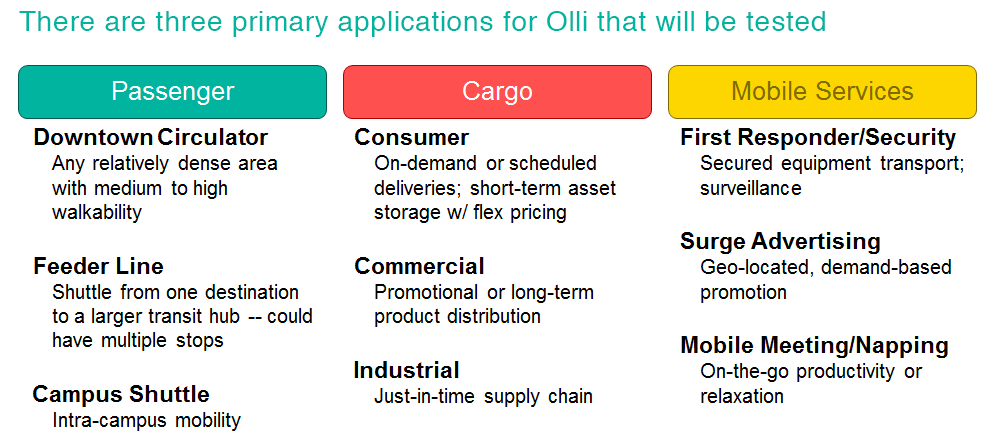Consider the disruptive impact of the Model T; Ford’s revolutionary car didn’t just deliver a new vision of automobile as a product, it also changed forever how motor vehicles are produced, how they are used and the very nature of the automotive industry.
Recently, a vehicle has arrived with similar potential: Olli.

Watch the video here.
The Olli mini bus is a new vision of transportation that encompasses all the trends that are on the verge of transforming the car industry—from additive manufacturing, to autonomous driving, to artificial intelligence, to mobility-as-a-service. And while it’s far too early to predict the impact of Olli itself, the vehicle’s technology and development process could provide a roadmap for carmakers both large and small that are grappling with the changes buffeting their industry.

Artificial intelligence for the real world
Olli is built by Local Motors, the startup famous for creating the first 3-D printed car. However, the brains for Olli were provided by IBM, which contributed its Watson artificial intelligence technology to the vehicle.
Together, IBM and Local Motors have produced a vehicle that does far more than simply drive a predetermined route. Instead, Olli combines the capabilities of a chauffeur, a tour guide and a technology expert to communicate with passengers using spoken conversational language. Powered by IBM Watson's Natural Language API and Internet of Things (IoT) for Automotive, Olli can take passengers to requested destinations, provide recommendations on where to go and answer questions about the vehicle, the journey and the surrounding environment.
The system is context aware, sensing the environment to adjust how it interacts with passengers. For instance, on a hot day, Olli might suggest going for some ice cream—and then transport the passengers to the closest Ben & Jerry’s.
For citizens of Maryland, many of whom have never seen a self-driving car, Watson’s reassuring communications could be critical to making them more comfortable with the idea that there’s no human being at the wheel.
Olli gets on the road
Olli itself may not look like a sleek concept car of the future, with a boxy, largely transparent body that resembles a picture frame on wheels.
The vehicle uses electric propulsion and carries up to 12 passengers. The first Olli will transport passengers at Maryland’s National Harbor, a waterfront development near Washington D.C. that features shops, restaurants and other attractions. Olli will not travel on actual public roads, but will traverse pedestrian pathways in National Harbor during a trial run expected to last three to four months.
Sharing the wealth
But despite its stodgy appearance, Olli is right at the cutting edge of a development that’s sweeping the automotive industry: the fundamental shift in automakers’ business models away from selling cars and toward offering mobility services.
This phenomenon has its origins in the booming popularity of ridesharing. In light of this trend, major automakers including Toyota and General Motors have entered into various types of partnerships with the leading ridesharing services, i.e. Uber and Lyft.
At the same time, ridesharing services and automakers alike are examining autonomous car technologies while also entering into business and technology partnerships with the firms that are actually developing self-driving vehicles, including Apple and Google.
Auto autonomy
All this is leading to a potential future where people use ridesharing services consisting of fleets of autonomous cars—all available on demand via mobile apps. Some experts believe such self-driving cars could be the antidote to the overcrowding and pollution plaguing today’s cities, providing a more efficient approach to road transportation.
Similar to Ford’s transformative vision of his Model T as a product that would bring motor cars to the masses—as opposed to a luxury form of transportation exclusively for the rich—the mobility-as-a-service phenomenon promises to fundamentally alter the car business. In the future, fewer consumers may own cars, instead using autonomous ridesharing services.
Get smart
It’s hard to overstate the potential level of disruption this event could cause to the global automotive industry. The addition of self-driving capabilities and a layer of artificial intelligence to make the autonomous car experience acceptable and appealing to consumers requires a level of expertise that not all automakers possess.
“When you get to this level of digital differentiation not all car makers are equally up to snuff,” said Kal Gyimesi, automotive marketing leader at IBM. “During the next few years, while there’s still a lot of manual driving occurring, every car company can stay in the game. But the more you see digital becoming the differentiator for consumers, the more difficult it’s going to be for everybody to compete.”
A roadmap for smarter cars
The Olli collaboration between IBM and Local Motors demonstrates how automakers can acquire the capabilities required to move ahead with their own AI-enabled vehicle concepts.
To allow seamless interactions between Olli and the passengers, Olli employed four developer APIs from Watson IoT for Automotive: Speech to Text, Natural Language Classifier, Entity Extraction and Text to Speech. IBM has made these and other automotive-oriented APIs available on the cloud using the company’s BlueMix platform-as-service. BlueMix is designed to aid developers, independent firms and enterprise teams.
With the APIs available on the cloud, Local Motors was able to add Watson’s capabilities to Olli quickly and easily.
Big innovation in micro factories
The use of the IBM cloud APIs fits in with Local Motors philosophy of rapid innovation and production.
The Olli autonomous mini-bus concept was designed in just a few months leveraging the Local Motors crowd-sourced innovation community. The company says this approach allows the development of vehicle concepts five times faster and at one-hundredth the cost compared to traditional automakers. Olli moved from design to production in less than one year.
Just as Ford’s assembly line revolutionized car production, Local Motors is departing completely from conventional car-manufacturing techniques. The company’s micro factory approach localizes production where the vehicles will be used, accelerating time to market. In parallel with the Olli rollout, Local Motors opened a new micro factory in National Harbor.
The micro factories make extensive use of cutting-edge 3-D printing technology to quickly produce products.
Back to the future
By using new technologies like 3-D printing, crowdsourced development, cloud-based APIs and advanced artificial intelligence, Local Motors has been able to move faster than the giant carmakers—and develop more products that are more innovative in many regards. The arrival of such technologies could have a democratizing impact on the car industry, allowing tiny startups to compete and even move beyond the industry’s established behemoths.

As the major carmakers consider the potential impact of Olli, they need to remember what happened to Ford’s established rivals following the arrival of the Model T. To stay in business, American car makers were forced to quickly adopt the assembly-line production techniques pioneered by Ford—or go extinct. And in the age of the mobility-as-a-service revolution, extinction is a distinct possibility for those that don’t keep pace.
Additional Information:
• Learn more about Watson IoT Platform
• Start using Watson IoT Platform for free
• Get started using Watson IoT and Node-RED (Recipe)
• Get certified on Watson IoT Platform with the Developer’s Guide to IoT
• Explore IoT for Automotive
Content provided by AspenCore and IBM
Advertisement
Learn more about IBM





